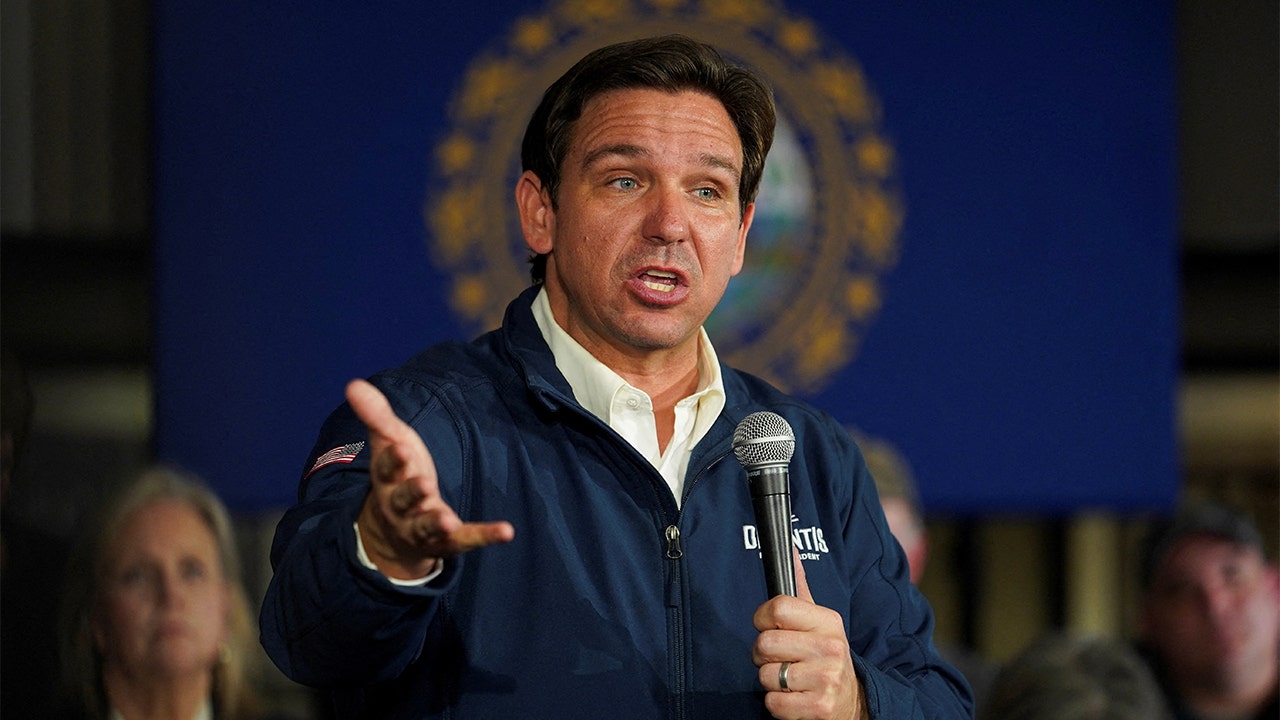KRAMATORSK, Ukraine — As Ukraine prepares to mobilize tens of thousands of men to address a critical shortage of soldiers amid intensified Russian attacks, Ukrainian commanders in the field say they are bracing for most of the new troops to arrive with poor training.
Washington
Washington GOP leaders propose bill to allow opting out of Washington Cares Act

The state’s top Republican legislative leaders on Monday announced a proposed bill that would allow Washington workers to opt out of the state’s new long-term care payroll tax.
“When you actually do the math, it doesn’t work out. That’s what we have here, a solution that simply doesn’t work, and the people of the state of Washington know it doesn’t work,” Sen. John Braun, R-Centralia, said during a virtual press conference.
The first-in-the nation program, the Washington Cares Act, allows eligible individuals to collect a lifetime benefit of up to $36,500. That money, which is funded through a 0.58 percent payroll tax that went into effect July 1, can be used to pay for in-home nursing care, rides to the doctor and other health needs.
The new tax equates to $58 per year for every $10,000 earned. For someone making $50,000 per year, the tax equals $290 per year or $24.17 per month.
The Democratic-led Legislature pushed the long-term care bill through in 2019. During the 2022 session, rollout of the program was delayed 18 months to address financial solvency and other issues with the program.
Braun, who represents the 20th District, said a mandatory payroll tax creates yet another burden for workers already struggling to survive. Instead, he said the Republican-sponsored bill would make participation optional.
“It’s just one more step making Washington state unaffordable for a whole group of workers,” he said. “It it’s really such a great idea, the people of state of Washington are capable and smart enough to decide for themselves.”
State Sen. Lynda Wilson, R-Vancouver, from the 17th District, joined Braun for the virtual press conference. Wilson, the Republican leader on the Senate Ways and Means Committee, said there was good reason to delay the program.
“Most Republicans voted last year for the bill that delayed the payroll tax collection until after our 2023 legislative session. I did so in part because the longer delay allowed more time to consider adjustments that might deal with the flaws in this program — one of the biggest of which is the lack of portability,” Wilson said.
In addition to being flawed, Wilson said the program is unpopular with many voters. She said a 2019 advisory vote showed more than 60 percent of voters didn’t want the long-term care program, but Democratic lawmakers didn’t listen.
“We need to start listening to them. The ability to opt out now is a good idea,” she said.
Braun said a publicly funded program isn’t needed because private insurance coverage is already available and often provides better coverage for the same or better cost.
In addition to making the program optional, the bill would allow individuals who opted out prior to Dec. 31, 2024, to receive a refund for any long-term care taxes paid.
While the 2024 legislative session start date hasn’t been announced yet, Braun the bill will be prefiled in December.

Washington
Basic training in Ukraine is barely covering the basics, commanders say

An influx of conscripts under the new law is still months away. In the meantime, commanders are redeploying soldiers from rear positions to fighting units near the front. President Volodymyr Zelensky last month also signed a law to allow some prison inmates to join the military in exchange for a chance of parole — copying a Russian tactic that provided thousands more fighters but is also releasing violent criminals back into society.
Wherever the new soldiers come from, Ukrainian field commanders said that because training is so deficient, they must often devote weeks to teaching them basic skills, such as how to shoot.
GET CAUGHT UP
Summarized stories to quickly stay informed
“We had guys that didn’t even know how to disassemble and assemble a gun,” said a 28-year-old deputy battalion commander from the 93d Mechanized Brigade, whom The Washington Post agreed to identify by his call sign, Schmidt, according to Ukrainian military protocol.
Schmidt said that he spent the first week with soldiers transferred from rear posts just making sure each one fire at least one box of bullets — some 1,500 shots — daily before moving on to more complex tasks. Within weeks, these soldiers could be fighting near the embattled town of Chasiv Yar, where Russian forces have been making advances.
“We are just wasting a lot of time here on basic training,” Schmidt said, adding: “If, God forbid, there will be a breakthrough near Chasiv Yar, and we get new infantry that doesn’t know basic things, they will be sent there to just die.”
With Kyiv’s forces critically understaffed and losing ground, the failure to provide adequate basic training for soldiers underscores the dire situation Kyiv is facing more than two years after Moscow’s invasion.
Russia has made gains this year in large part because Ukraine’s military doesn’t have enough troops to defend against relentless assaults, soldiers say, while the government has been slow to ramp up its mobilization efforts.
To get more troops to the battlefield immediately, Zelensky’s recently appointed military chief, Col. Gen. Oleksandr Syrsky, has redeployed people who were previously serving in jobs such as guarding bridges and other infrastructure far from the combat zone to brigades engaged in some of the fiercest fighting.
The move was designed in part to reduce the number of men who would have to be drafted — an issue that is politically fraught for Zelensky. Syrsky’s predecessor, Gen. Valery Zaluzhny, had proposed drafting close to 500,000 people — a figure Zelensky publicly rejected by saying he had not been shown evidence that it was necessary and that Ukraine would struggle financially to pay so many new soldiers’ salaries.
For front-line commanders, any new troops are welcome, given that some units have endured months without reinforcements. But many of these redeployed arrivals appear ill-prepared, commanders said, despite many having served in the military since the start of Russia’s invasion more than two years ago, albeit far from the battlefield.
Until about a month ago, a Ukrainian soldier, whose call sign is Val, had been standing guard on a bridge in the southern Odessa region — the same job he’d been doing every day since he enlisted at the start of the invasion.
On April 30, Val was told that he was being transferred to combat duty. Within 24 hours, he was assigned to the 93rd Brigade and instructed to deploy to the eastern Donetsk region. He didn’t even have time to pack his things — some had to be shipped later.
“It’s scary,” the 31-year-old said. “Nobody was really prepared.”
For a reconnaissance unit in the 42nd Mechanized Brigade, which was recently redirected to the northeast Kharkiv region to defend against a renewed Russian offensive, many of the scouts had just been reassigned from rear roles and were given just two weeks preparation before being sent into combat, to carry out tasks that at times require sneaking behind enemy lines.
What is taught in Ukrainian training centers “is complete nonsense,” said a 32-year-old soldier in the unit with the call sign Chirva. “Everything is learned on the spot.”
An officer who has spent more than a year instructing new soldiers at one of Ukraine’s facilities said the training centers are low on Soviet-caliber ammunition because it is being saved for troops on the battlefield. That means recruits get little experience firing live rounds. The officer said the training center received just 20 bullets per person.
“There are no grenades for throwing in training centers, and there are no grenade launcher rounds in the training center,” said the officer, who spoke on the condition of anonymity because they were not authorized to do so publicly. “This is the problem.”
“We don’t have a proper training system in place,” the officer continued, adding that Ukraine needs its instructors to be taught by NATO trainers to condense the standard two-month basic training into one month.
A current priority for Ukraine’s General Staff is securing more training for recruits abroad — at facilities that can’t be targeted by Russian bombardment, unlike those in Ukraine. Britain so far has provided the most basic training for Ukrainians. In a potential boost, France is considering sending instructors to Ukraine to help prepare draftees, Syrsky said in a post on social media this week.
The prospect of being sent to dangerous front-line positions without adequate training is a main reason many Ukrainian men fear conscription. As part of a recruitment effort, the National Guard’s Khartia Brigade has billboards across the country promising “60 days of preparation.”
But despite individual brigades investing in ads to attract recruits — an internal competition of sorts within the military — those who enlist might not end up with their preferred brigade.
The chief sergeant for a battalion fighting in the eastern Donetsk region described a process in which certain brigades, particularly assault brigades, often get first pick of new soldiers brought to training centers.
The sergeant, who is typically sent to training centers to select troops for his battalion, spoke on the condition of anonymity to be candid and because he was not authorized to discuss the sensitive matter publicly.
Some assault brigades might devote personnel to live practically full-time near training centers, the sergeant said, to quickly snatch up the youngest, fittest, most motivated men. The officer who was an instructor at a training center confirmed that some brigades indeed plot for first dibs.
“If they send us to recruit someone, all the good ones have already been taken by other brigades, and you have to choose from the crooked, lame, sick ones,” the sergeant said. “And so you choose from them, dammit.”
The sergeant said that he aims to communicate with soldiers to get a sense for who is more willing to fight versus those who were conscripted forcibly and might refuse orders on the battlefield. This is expected to become an issue of heightened importance, as most Ukrainians eager to serve have already volunteered to do so. Those who have not yet volunteered tend to be resistant to fighting.
Some recruits, the sergeant said, are deemed physically fit despite being over age 50 with knee and back issues, meaning they will struggle to walk miles with a pack of gear and weapons, as is often required. Some brigades are ordered to take those men anyway.
“There are guys whom you just look in the eye and understand he’s hesitating,” the sergeant said. “He needs a push. He needs confidence in his weapon, confidence that we won’t abandon him, and he will fight.”
“And there are those who immediately say, ‘I won’t fight,’” he added. “Of course, you try not to take them. But again, in our army, it’s set up so that the personnel department tells you, ‘No way, you have to take him, he’s healthy.’”
Anastacia Galouchka in Kyiv contributed to this report.
Washington
June starts in D.C. as May ended, with a day of delight

The 81 degrees was a temperate sort of temperature, marking a day that seemed content to grant to barbecues to possess the undisputed right to sizzle, and to confine to food preparation any noticeable steaminess.
Saturday seemed a dry day in the most obvious sense, meaning that it did not rain, at least not through early evening. In the seeming absence of showers, or of their apparent likelihood, Saturday departed from a tradition established in May. Last month it rained on every Saturday, and on a couple of them it rained a lot.
But by early evening, D.C.’s first Saturday in June seemed to revoke the weekly permits for rain and clouds. Moreover, to the untrained eye, Saturday gave scarcely a sign that it would allow precipitation at night.
Clouds were indeed there on Saturday, but they seemed to be high clouds, perhaps five miles up, and thin, almost gauzy, as if made of some fragile fabric with strands that had been carefully teased apart.
Humidity, the unwelcome guest on many a warm day in Washington, seemed to make itself scarce. Such quantities as dew points and heat indexes often are cited as numerical explanations of warm weather discomfort. Although these quantities could be computed Saturday, they could readily be factored out of the comfort equation.
For example, at 2 p.m., with the mercury at 80 degrees, the dew point was recorded at more than 30 degrees below that. It was an almost absurdly low 49 degrees. In practice, it meant that no way existed to wring raindrops out of the uncharacteristically dry air.
East is east, and west is west, it is often said. But on Saturday, Washington seemed to show similarities to conditions often experienced near the other side of the continent. It seemed to display an uncommonly strong resemblance to sections of Southern California, at least in terms of meteorology.
In all of this, Saturday seemed to show its kinship with Friday, a day similar in so many ways. With a high temperature in the 70s, Friday was often described as an example of the sort of weather that should be summoned to the Washington area more often.
Washington
QB Sam Howell Admits ‘I Was a Little Too Aggressive’ With Washington Commanders

Quarterback Sam Howell filled his backup role as best he could while learning behind Washington Commanders quarterbacks Carson Wentz and Taylor Heinicke.
At the end of the Commanders’ 2022 season he got his first start against the Dallas Cowboys and immediately showed flashes of the talent that once had him projected to be a first-round pick in the NFL Draft.
READ MORE: Years Later Trent Williams Trade Still Haunts Washington
While Washington got Howell in the fifth round and waited 16 regular season games before giving him his first shot, the quarterback eventually started all 17 games in a four-win 2023 campaign that saw Howell sacked a league-high 65 times while throwing 21 interceptions.
“I think I could play some smarter ball. I think there were times where we were down big in some games, I was a little too aggressive just trying to make something happen trying to get us back in the game,” Howell said according to Jon Alfano of All Seahawks. “The turnovers are just way too high for what I wanted and what the team needed.”
“In this league to be able to play, you’ve got to compete and that’s what I’m willing to do, no matter what the situation is, no matter who the starter is.”
– Sam Howell, Seattle Seahawks Quarterback
It’s classic Howell to not let the blame land anywhere else but himself, but those who watched the Commanders closely last year know that it’s not all on the young quarterback. Perhaps more blame is owed to the coaching staff that has since departed, and then there’s some that needs to live with the roster around him.
Most of us here witnessing the launch of quarterback Jayden Daniels’ career still believe there’s a future NFL starter waiting in the wings in the Pacific Northwest. Even if Howell has to sit behind yet another more veteran quarterback while he waits for his next chance.
“In this league to be able to play, you’ve got to compete and that’s what I’m willing to do, no matter what the situation is, no matter who the starter is. If I’m the starter, I’m coming to compete every single day,” Howell told reporters Thursday . “Geno has been great. I’ve learned a lot from Geno and he’s a great player. I have a lot of respect for him and everything he’s been through in his career.”
Smith is almost the perfect quarterback to take a cast-out starter under his wing because he knows a thing or two about that situation. Even though Smith’s fall came from much higher heights, and is considered to be more about him than Howell’s departure from Washington is.
READ MORE: Logan Paulsen’s Early Takeaways from Quarterback Jayden Daniels
After being drafted No. 2 overall in the 2013 NFL Draft out of West Virginia, Smith spent four seasons with the New York Jets before eventually heading to the New York Giants, Los Angeles Chargers, and finally the Seattle Seahawks where he got his second chance at being a franchise quarterback.
Stick with CommanderGameday and the Locked On Commanders podcast for more coverage of the Washington Commanders throughout the 2024 season.
-

 News1 week ago
News1 week agoRead the I.C.J. Ruling on Israel’s Rafah Offensive
-

 News1 week ago
News1 week agoVideo: Protesters Take Over U.C.L.A. Building
-

 World1 week ago
World1 week agoHoping to pave pathway to peace, Norway to recognise Palestinian statehood
-

 News1 week ago
News1 week agoLegendary U.S. World War II submarine located 3,000 feet underwater off the Philippines
-

 World1 week ago
World1 week agoFamilies of Uvalde school shooting victims sue Microsoft, Meta and gunmaker
-

 Politics1 week ago
Politics1 week agoHunter Biden attends pre-trial hearing in Delaware court on federal gun charges
-

 Politics1 week ago
Politics1 week agoDefense Secretary Lloyd Austin to undergo nonsurgical procedure, Deputy Kathleen Hicks will assume control
-

 News1 week ago
News1 week agoHere are three possible outcomes in the Trump hush money trial : Consider This from NPR






/cdn.vox-cdn.com/uploads/chorus_asset/file/25472756/sff_ready_enthusiast_geforce_case_nvidia.jpg)









